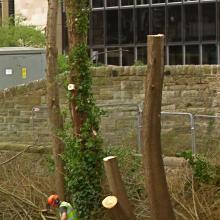
The Water of Leith Conservation Trust is a charity established in 1988 'to conserve and enhance the Water of Leith as a haven for wildlife and an educational and recreational resource for all.'
Most people are well-disposed towards the Trust. They admire its excellent work in energising volunteers and communities to care for the river, encouraging improved public access to, enjoyment of and knowledge about this wonderful habitat.
But in recent days Spurtle has spoken to a surprising number of locals who are critical of the Trust's 'very disappointing silence' over recent events around Canonmills.
Spurtle decided to grasp the nettle by the horns, and approached Trust Manager Helen Brown for answers.
Is she aware of discontent in the air?
A rueful sigh greeted this question. Brown says she has been fielding a great many 'Angry of Canonmills' calls lately, and is in no doubt about the strength of local feeling. However, her next response is a little surprising. She attributes much of the heat in the Stop the Chop campaign to a reaction against earlier wholesale tree felling downstream of the bridge alongside Warriston Crescent and Warriston Road.
'Our involvement in that took place five years ago during consultations with Arup, the Council, and Lagan. We had endless site visits, meetings with engineers and residents. It became apparent that simply heightening flood defence walls would not prevent seapage underground, and that piling to the necessary depth would inevitably cut through roots leaving mature trees unstable.
'It was an enormous shame, and we did express our concern at the time. But we were convinced that if we were to protect these houses, there was no alternative to felling.
'Having made that reasonable decision, we couldn't then turn round five years later and start criticising it.'
But the Stop the Chop campaign was specifically focused on preserving trees upstream of Canonmills Bridge, and anomalies between the Council's planning permission to effect that and the contractor's proposed methodology. What was the Trust's stance on that?
Again, Brown argues that the Trust's main activity on this stretch of the river had been completed years ago, at the planning rather than methodology stage.
'There were some issues which had not been nailed down [the protection of certain trees and alternative access arrangements] and which I suppose you could say later fell through the loop.
'But by that stage we had moved on. We were fully engaged in planning Phase 2 of the flood defences, and 1001 emotive issues arising out of losses to Murrayfield allotments. In that context, I am sorry to say the fate of a handful of 40–50-year-old trees in Canonmills was not high on our agenda.'
Was the Trust aware in advance that Cllr MacKenzie would last week rescind an earlier agreement concerning trees upstream of Canonmills Bridge?
'No. We learned on Thursday along with everybody else.'
Why didn't the Trust say something?
'We had looked earlier at alternative proposals for how to access the work – building another temporary road across the riverbed or felling trees along the bank. Frankly, neither of them was environmentally preferable. We ended up favouring the option which would allow the work to be finished most quickly.
'In any case, I think our job is far better achieved through involvement in planning rather than discussion in the media.
'I have been over this issue a number of times with locals, and would like to assure people that the Trust is not sitting idly by.'
How does Brown react to suggestions that by working 'in partnership' with the Council, the Trust has become too pally?
'That's absolutely not the case. If we felt CEC were doing something detrimental to the river, we would tell them. As it is, we meet Countryside Rangers weekly, and representatives of six departments on a six-monthly basis through the Management Committee.'
Does the Water of Leith Conservation Trust dare rock the boat when it comes to its biggest funder?
'The relationship is not like that. CEC values and needs the Trust. The Council doesn't own the river – ownership beside Warriston Crescent, for example, extends out from each house to the bank and on to a point mid-stream. Coordinating work is an immensely complicated process of consultation and compromise. CEC and the Water of Leith Conservation Trust have to operate together to achieve that.'
*****
So have we learned anything? Readers will draw their own conclusions – and we'd like to publish them – but it seems to the Spurtle that the Trust is genuinely working hard, albeit with the occasional slip, and independent-mindedly, for the good of the river. We accept that, with limited staff and resources, it is necessary for it to concentrate efforts on the detailed planning work in which it has most expertise and influence.
As you might expect, we are less convinced by its stance on public relations. Yes, giving loud and public expression to decisions made years before is time-consuming, distracting, and apt to be misinterpreted. But media relations are an intrinsic part of today's world, and intrinsic also to any major project of this kind which runs bulldozers, pile-drivers and chainsaws through one of the city's most treasured resources.
Not everyone is an expert. Normal residents need repeated doses of information and reassurance, and the Water of Leith Conservation Trust is ideally placed to provide them.